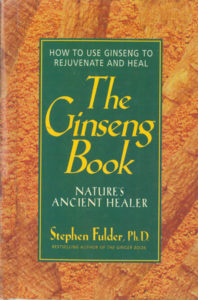 The Ginseng Book: nature’s ancient healer. / Stephen Fulder. Avery Publishing Group, Garden City, New York, 1996.
The Ginseng Book: nature’s ancient healer. / Stephen Fulder. Avery Publishing Group, Garden City, New York, 1996.
If a “man-root” (or “man-woman root”) exists, not for our entertainment, but for attainment of radiant health, it is the fleshy root of the perennial Panax ginseng, commonly known as Ginseng. This root was recognized for its human-like shape, a relationship between a plant and its human consumers described in the doctrine of signatures. This healing philosophy says that plants take the shape of an organ or part of the body which it is best suited to heal. With ginseng, its shape corresponds to the whole body—arms, legs and torso.
“…ginseng is a tonic to the five vicera… and if taken for some time, it will invigorate the body and prolong life…” This quote, from the Divine Husbandman, written in the 2nd century B.C. indicates why the Chinese have such reverence for the root. Contemporary pharmacopeias list fatigue, amnesia, aging, tuberculosis, diabetes, heart and kidney diseases, and nervous debility as some of the conditions ginseng is known to relieve. Yet the author offers later on page 11:
“Its ability to increase general vitality is what makes it so precious in the
eyes of the Chinese, for they regard vitality as the essence of health.”
The physical shape and healing essence of the mature root of the ginseng plant amazed Chinese herbalists five thousand years ago when they created a classification of healing plants for their pharmacies. They placed it among the kingly herbs that possess special substances for maintenance of youth, stamina and strength, making it quite unlike stimulants we choose such as coffee. And ginseng’s ability to return the body to normal, from a point of ill health, is legendary in Asia.
As a plant root, like any tuberous vegetable, ginseng could be eaten for great health benefit. The Chinese found, though, that it’s not suitable as the cure for a particular disease. Otherwise, ginseng is found in many Chinese medicine formulas designed to achieve general premium health goals. So described, its properties are warming, best suited to use in the colder seasons. And it’s used for the purposes of increasing Yang, a Chinese term for heat energy.
In modern times, pieces of ginseng root are chewed, or steamed in a ginseng cooker, for an elixir tea. You may have tasted ginseng granules that came in a foil packet much the size of a typical tea bag. The granule tea consists of the product of spray-dried ginseng and a starch to make the tea available for instant brewing.
While it’s obvious that the author has a deep reverence for Ginseng, both culturally and in the testing lab, this version of a testament to the herb falls a little short for me. Compared with his earlier work, The Book of Ginseng and Other Chinese Herbs for Vitality by Stephen Fulder, Healing Arts Press, 1993 (c1980), this book on the same subject and purportedly the same kind of information, is actually about 1/3 the size of the earlier one. In this book, I keep looking for footnotes or chapter notes to substantiate what’s written here. A topic of this kind really requires that support, and we need to know on what grounds the author makes claims for this wonder herb / drug. Yet something is missing to make it worthy of handbook status, the sort of local referencing of fact, image, lore and medical results. From this book, the reader cannot imagine the relationship of ginseng and the brain’s hormones, an area of discussion that adds to the marvel of this root.
To dream about ginseng as a wonder drug, to understand how it can improve health and longevity, to gain the broader view of its reputation in China and the Far East, I prefer the author’s previous work, The Book of Ginseng and Other Chinese Herbs for Vitality (Healing Arts Press, 1993 (c1980). In it, the author’s creative approach to discovering the genius of the herb is a positive complement to its frank discussion of the root, both culturally and medically in China, and more recently in Russia, Japan, Korea, and South America, etc.
“The Book of Ginseng and Other Chinese Herbs for Vitality” by Stephen Fulder published in 1980 was reviewed on this blog, here.
Follow


